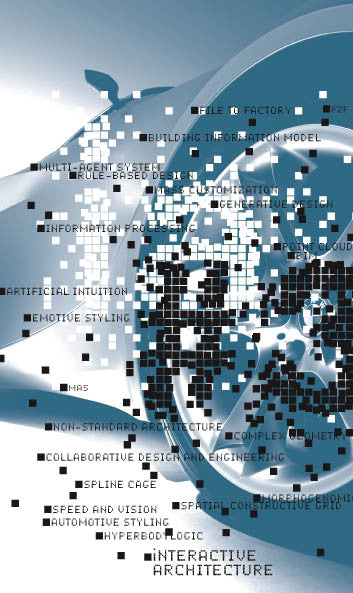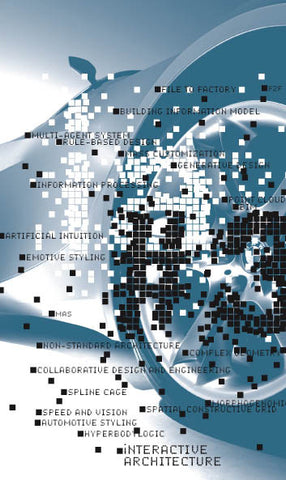Your cart is currently empty!
iA#3 - Interactive Architecture
+++Emotive Styling+++
+++Kas Oosterhuis, Xin Xia, Owen Slootweg [eds]+++
978-94-90322-08-3
Danielle van Steenbergen
128
12 x 21
Paperback
This iA bookazine series consists of twelve issues bi-annually published under the supervision of prof. ir. Kas Oosterhuis, director of Hyperbody at the Delft University of Technology and principal ONL [Oosterhuis_Lénárd] bv. The issues of iA consist of scientific papers on particular aspects of iA and iA-driven MSc projects, iA-inspired case studies from practice, interviews with renowned researchers/practitioners, and blogs by Kas Oosterhuis.
English
Date of release: maart 2010
The iA-bookazine series brings together interdisciplinary contributions on the topic of 'Interactive Architecture (iA)' from researchers, students, guest lecturers from Hyperbody, Factulty of Architecture, Delft University of Technology and experts from various other organizations. This third issue consists of papers, educational reports, workshops, dialogues and related information.
The theme for iA#3 is Emotive Styling. In the introduction, professor Kas Oosterhuis emphasizes the urgency of developing a style for a non-standard architecture based on complex geometry and interaction design. Gijs Joosen interviews BMW design director Chris Bangle for iA#3; they discuss the relevance of the emotive behaviour of the BMW Gina prototype. Style, determined by a specific speed (120 km/h), is the leading conceptual idea for the design process applied to ONL's Acoustic Barrier for the embedded Cockpit. At the same time, the applied innovative CNC fabrication techniques were developed with the explicit purpose of strengthening the initial design concept.
Equipping themselves with emotive styling techniques in the design process, Hyperbody aims to encourage interaction designers to imagine the daily motion of any built structure. For the Festo HyperWall, exhibited at the Hannover Fair 2009, Hyperbody designed and programmed the smooth emotive behaviour of nine wall units, and designed and programmed the dynamics of the embedded LED lights and sounds. A group of Hyperbody MSc3 students have developed several projects as an information processing DNA structure, operating on the Dutch A2 Highway. Finally, Hyperbody thesis student Owen Slootweg explains his interactive design concept for Europe's first fly-over crossing Kleinpolderplein in Rotterdam.
Emotive Styling
€18.00
iA#3 - Interactive Architecture
Emotive Styling
€18.00
Architecture / Bookazines / Series / Theory / Urbanism
978-94-90322-08-3
Danielle van Steenbergen
128
12 x 21
Paperback
This iA bookazine series consists of twelve issues bi-annually published under the supervision of prof. ir. Kas Oosterhuis, director of Hyperbody at the Delft University of Technology and principal ONL [Oosterhuis_Lénárd] bv. The issues of iA consist of scientific papers on particular aspects of iA and iA-driven MSc projects, iA-inspired case studies from practice, interviews with renowned researchers/practitioners, and blogs by Kas Oosterhuis.
English
Date of release: maart 2010
The iA-bookazine series brings together interdisciplinary contributions on the topic of 'Interactive Architecture (iA)' from researchers, students, guest lecturers from Hyperbody, Factulty of Architecture, Delft University of Technology and experts from various other organizations. This third issue consists of papers, educational reports, workshops, dialogues and related information.
The theme for iA#3 is Emotive Styling. In the introduction, professor Kas Oosterhuis emphasizes the urgency of developing a style for a non-standard architecture based on complex geometry and interaction design. Gijs Joosen interviews BMW design director Chris Bangle for iA#3; they discuss the relevance of the emotive behaviour of the BMW Gina prototype. Style, determined by a specific speed (120 km/h), is the leading conceptual idea for the design process applied to ONL's Acoustic Barrier for the embedded Cockpit. At the same time, the applied innovative CNC fabrication techniques were developed with the explicit purpose of strengthening the initial design concept.
Equipping themselves with emotive styling techniques in the design process, Hyperbody aims to encourage interaction designers to imagine the daily motion of any built structure. For the Festo HyperWall, exhibited at the Hannover Fair 2009, Hyperbody designed and programmed the smooth emotive behaviour of nine wall units, and designed and programmed the dynamics of the embedded LED lights and sounds. A group of Hyperbody MSc3 students have developed several projects as an information processing DNA structure, operating on the Dutch A2 Highway. Finally, Hyperbody thesis student Owen Slootweg explains his interactive design concept for Europe's first fly-over crossing Kleinpolderplein in Rotterdam.



